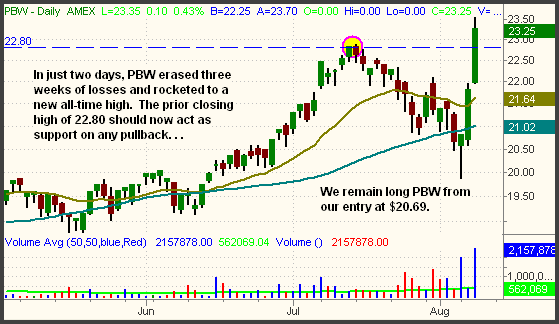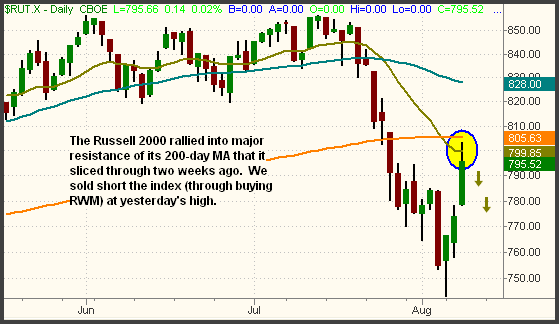| The Wagner Daily ETF Report for August 9 |
| By Deron Wagner |
Published
08/9/2007
|
Stocks
|
Unrated
|
|
|
|
The Wagner Daily ETF Report for August 9
Stocks scored their third consecutive day of gains yesterday, but the afternoon was nearly as volatile and indecisive as the previous day. This time, it wasn't caused by a Fed meeting. The broad market trended steadily higher throughout most of the session, then sold off sharply in the final ninety minutes. Buyers returned with just ten minutes remaining, pushing the major indices back to the upper third of their intraday ranges. The Nasdaq Composite led with a 2.0% gain, as the S&P 500 rallied 1.4%. Curiously, the Dow Jones Industrial Average dipped all the way to negative territory just thirty minutes before the closing bell, then ripped 150 points higher in the final minutes to settle with a 1.1% gain. A relief rally in the laggard Russell 2000 sent the small-cap index 2.8% higher. The S&P Midcap 400 advanced 1.3%. Due to a rally into resistance of its 20-day EMA, we sold our long position in the Fidelity Nasdaq Composite Index (ONEQ) for a gain of just under 3 points.
Turnover picked up across the board, enabling both the S&P and Nasdaq to register another "accumulation day," the second of the past three sessions. Total volume in the Nasdaq rose 30% above the previous day's level, while volume in the NYSE increased by 15%. Technically, the session was marked by institutional buying, but the higher volume would have actually been negative if not for the rally off the intraday lows just before the closing bell. Although volume was one of the highest days of the year, the bullish implication may have been deceiving because most of the volume surge occurred when stocks began selling off in the afternoon. Overall, we are hesitant to place much bearing on yesterday's "accumulation day."
In yesterday's commentary, we explained the reasons for buying the PowerShares Clean Energy Fund (PBW) when it gapped down the previous day. After rallying nearly 5% on Tuesday, we expected a bit of price consolidation before moving higher, but PBW followed-up in yesterday's session with an even more impressive gain of 6.6%! That combined 11.6% gain caused PBW to wipe out its three-week correction in just two sessions. Take a look:

Upon buying PBW, we said our intention was to hold the position to a new high, with a projected time frame of at least several weeks. To our surprise, it rocketed to a fresh all-time high in just two days. Now that we already have an unrealized gain of 20% on the position, we will simply focus on trailing our stop higher to protect gains and maximize profits. When a stock or ETF is trading at an all-time high, we rarely use specific price targets. The complete lack of overhead price resistance often enables positions to go much higher than one would ever expect. As such, trailing stops are a good way to ensure we're not cutting the profits short.
Along with rumors that Goldman Sachs would issue a profit warning after the close (which they later denied), the big reason for yesterday afternoon's erratic action was that many of the major indices ran into key resistance levels. The S&P 500 struggled with resistance of its prior lows from June, while its 50-day MA loomed just overhead. The Dow ran into its 61.8% Fibonacci retracement level, along with its prior highs from June. The Nasdaq briefly popped above its 50-day MA, but closed right below it. With such significant levels of overhead supply and technical price resistance, one must assume the markets will initially have a difficult time overcoming them. Unless the major indices blast through yesterday's highs, expect more indecision today.
Our short position in the iShares Emerging Markets (EEM) hit our stop by just 3 cents before reversing lower into the close. However, we initiated a new short position in the Russell 2000 Index, at its intraday high, right after EEM stopped out. By day's end, the new short position in the Russell was showing more of a gain than EEM subsequently retraced back down. Rather than selling short the iShares Russell 2000 (IWM), we bought the inversely correlated ProShares Short Russell 2000 (RWM). The reason for the short entry was that the Russell 2000 had run into major resistance of its 200-day moving average that it sliced through two weeks ago:

Given that small-caps showed the most weakness during the first leg of the market's correction, we anticipate it will also be a downside leader if/when stocks head back down for a retest of the August lows. Although the broad market has entered a short-term uptrend, don't forget that the dominant, intermediate-term trend remains down. But even if stocks manage to hold current levels and attempt to move higher from here, we can expect the Russell to have difficulty keeping up. A lot of overhead supply remains in the wake of its rapid sell-off. We're giving the RWM position a bit of "wiggle room" around the 200-day MA, but will stop out of the position if the Russell moves back above its 50-day MA.
Open ETF positions:
Long - PBW, RWM
Short - (none)
Deron Wagner is the Founder and Head Trader of both Morpheus Capital LP, a U.S. hedge fund, and Morpheus Trading Group, a trader education firm launched in 2001 that provides daily technical analysis of the leading ETFs and stocks. For a free trial to the full version of The Wagner Daily or to learn about Wagner's other services, visit MorpheusTrading.com or send an e-mail to deron@morpheustrading.com.
|